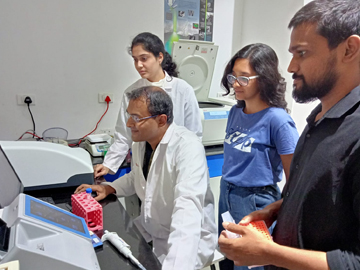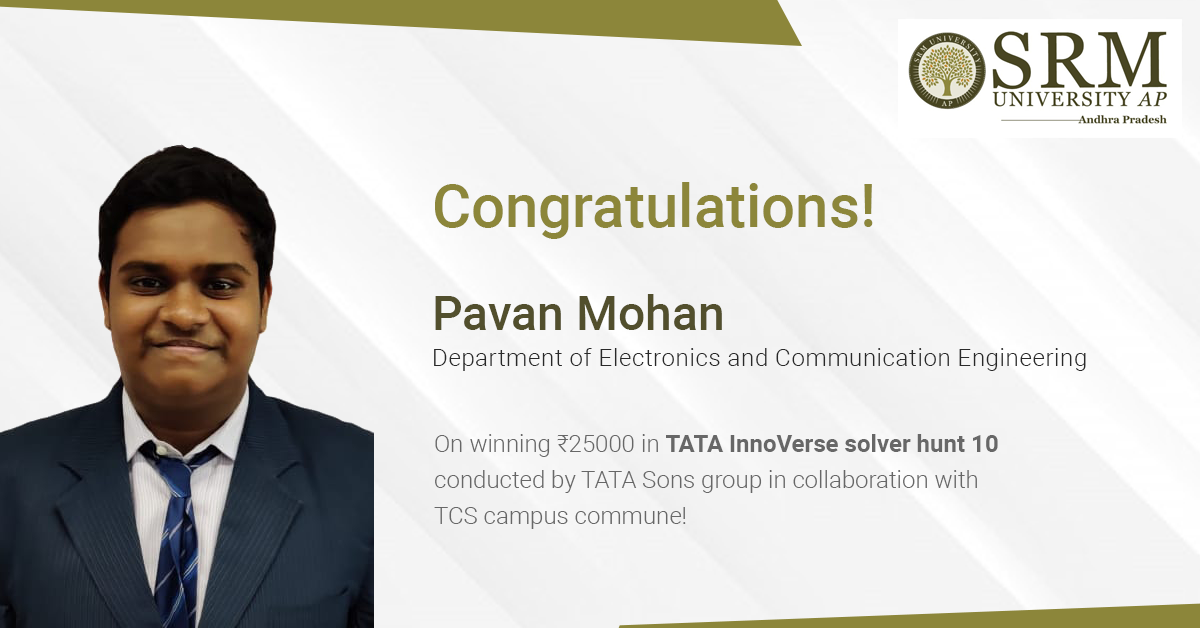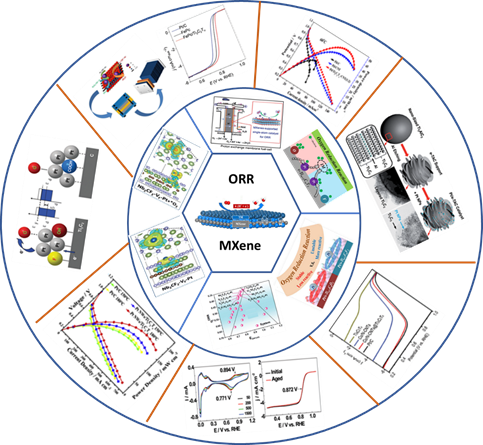Dr Sumit Kumar publishes two research articles in reputed journals
 Dr Sumit Kumar, Assistant Professor from the Department of Management has recently published two papers in highly reputed Scopus indexed journals. The paper titled “Managing employees’ turnover: findings from AHP model” is published in the International Journal of Economics & Business Research and “Economic Prosperity and Environmental Sustainability: Role of Infrastructure Development” in the Indian Journal of Ecology.
Dr Sumit Kumar, Assistant Professor from the Department of Management has recently published two papers in highly reputed Scopus indexed journals. The paper titled “Managing employees’ turnover: findings from AHP model” is published in the International Journal of Economics & Business Research and “Economic Prosperity and Environmental Sustainability: Role of Infrastructure Development” in the Indian Journal of Ecology.
Managing employees’ turnover: findings from AHP model is an attempt to compare and evaluate the relative significance of myriad HR issues leading to better management of the employee turnover problem. The research questions explored and examined in this study provided deeper insights and a better understanding of the problem of retaining and nurturing human capital and have relevant implications for scholars, policymakers, and retail organisations. An important theoretical contribution of the study is in enriching the literature on employee retention in the organised retail sector. The practical implications of this study mainly emanate from the results of this study and are related to practices of managing people at work. The findings of the study can be effectively used to design a robust retention policy.
Read the full paper here
The second paper titled Economic Prosperity and Environmental Sustainability: Role of Infrastructure Development is co-authored by A. Mishra, M. Sharma, and et. al. This pragmatic investigation strives to divulge the relationship between infrastructure expansion and environmental defilement in the Indian outlook by realistically exerting panel data of 10 Indian states, which contributes 70 per cent of the total national population. The precise outcome of the investigation demonstrates that some proxies of infrastructure improvement such as electric capacity, railways network, road network and telecommunication have linkage with the air quality index in India.
Dr Sumit Kumar is an Assistant Professor in the School of Entrepreneurship and Management Studies, SRM University AP, Andhra Pradesh, India. He has done his PhD from the Indian Institute of Technology (Indian School of Mines), Dhanbad in Marketing Management. He has eight years of rich experience in the industry, research, and academia. His research, interests focus on the areas of marketing and consumer behaviour, green products, private label brands (PLB), virtual retail environment and online retail. He has also presented papers at premier national and international conferences. He authored and co-authored several research articles in reputed international and national journals.
- Published in Faculty, News, Paari Current Happenings, Research News
C&EN features Dr Anil’s Research on sustainable biofilm
 Dr Anil K Suresh’s innovative research has been brought into the limelight by the revered weekly magazine Chemical & Engineering News (C&EN), published by the American Chemical Society. Dr Anil K Suresh, Associate Professor, Department of Biological Sciences, and his team from SRM University-AP recently developed a see-through transparent (with 85% above transmittance) biotemplate which they derived from the fish scale wastes to substitute the extensive usage of eco-unfriendly disposal plastic cuvettes for UV-Visible Spectroscopy measurements in the spectrum of 350-900 nm.
Dr Anil K Suresh’s innovative research has been brought into the limelight by the revered weekly magazine Chemical & Engineering News (C&EN), published by the American Chemical Society. Dr Anil K Suresh, Associate Professor, Department of Biological Sciences, and his team from SRM University-AP recently developed a see-through transparent (with 85% above transmittance) biotemplate which they derived from the fish scale wastes to substitute the extensive usage of eco-unfriendly disposal plastic cuvettes for UV-Visible Spectroscopy measurements in the spectrum of 350-900 nm.
UV-Vis spectroscopy is a versatile analytical tool used to examine the nature of various synthetic, biological and clinical molecules for pharmaceutical and environmental applications. The team members demonstrated the practical on-biotemplate analysis of diverse analytes such as DNA, proteins, nanoparticles, organic dyes, bacteria, BSA assay and dye-degradations. Dr Anil K Suresh owns the copyrights for this pathbreaking invention by being granted an Indian patent. This work was published in the prestigious Journal “Green Chemistry” by the Royal Society of Chemistry. Read the full paper here.
Chemical & Engineering News (C&EN), which is widely known to feature articles of the best professional and technical innovative research work and analysis in the fields of chemistry and chemical engineering, has acknowledged Dr Anil’s research by allowing it little room in their magazine in Volume 99, Issue 36 (Read the news here). C&EN includes information on recent news and research in chemistry and chemical engineering along with career and employment information, business and industry news, government and policy news, funding in these fields, and special reports.
“The magazine is very celebrated among researchers across the world. It is a great honour for my team and me to be featured in the magazine. This news magazine usually picks only top nature cell science publications among thousands, and My team and I are feeling great to be one of them,” said Dr Anil. Dr Anil further said that it would not be possible to carry out such prominent research work in a newly built establishment without the constant support from the management of SRM University-AP, Andhra Pradesh. He has profoundly thanked Dr P Sathyanarayanan, President; Prof V S Rao, Vice-Chancellor; Prof D Narayana Rao, Pro-Vice-Chancellor, for their kind help and cooperation.
The University Management congratulated Dr Anil K Suresh on his achievement. Dr Sathyanarayanan said, “It is indeed a proud moment for the university to be featured on C&EN. I compliment Dr Anil and his team on their tireless work.” “Dr Anil and his team have executed an extraordinary work towards a green environment which should be emphasised in international journals. The Team’s dedication towards their research is commendable,” said Prof V S Rao. Prof D Narayana Rao opined that Dr Anil K Suresh is one of the most talented young biologists in the nation. “I have personally known him for some time being and working with him for a few years. Dr Anil is devoted biologist and pride of the university,” asserted Prof D Narayana Rao.
- Published in Biology News, Faculty Achievements, News, Research News, Students Achievements
Pavan Mohan wins TATA InnoVerse SolverHunt Challenge bagging Rs.25,000
 SRM University-AP is proud to announce that Pavan Mohan Neelamraju, a student of the Department of Electronics and Communication Engineering (ECE) has shown extraordinary problem-solving abilities and won the TATA InnoVerse SolverHunt 10 and has been rewarded with Rs. 25,000.
SRM University-AP is proud to announce that Pavan Mohan Neelamraju, a student of the Department of Electronics and Communication Engineering (ECE) has shown extraordinary problem-solving abilities and won the TATA InnoVerse SolverHunt 10 and has been rewarded with Rs. 25,000.
The TATA InnoVerse SolverHunt poses challenges to aspiring innovative students in the fields of scientific and technological research. The students are required to come up with solutions individually and the most viable solutions are rewarded with exciting cash prizes, certificates of recognition and an invaluable opportunity to learn from experts in the industry.
Pavan’s challenge in the TATA InnoVerse SolverHunt was to classify steel wire bundles based on their shining appearance. Pavan developed an algorithm which quantified the gloss in the image using image processing and machine learning techniques. The algorithm went through three rounds of rigorous evaluation before being declared best.
Though Pavan worked on his solutions all by himself adhering to the guidelines of the TATA InnoVerse SolverHunt, he believes his vastly flexible course choices helped him a lot. The knowledge and perspective he gained in “Artificial Intelligence and Machine Learning” coupled with the hands-on experience he acquired while working on cutting edge technology as a part of Next Tech Lab at SRM AP enabled him to make vital winning decisions.
“The academic work has actually helped me to think out of the box and to imagine a wide range of possibilities to a single problem,” Pavan thanked Dr Ramesh (HOD ECE) and Prof. Siva Shankar along with the faculty of ECE Department for grooming him. In industrial problems such as the ones provided by TATA InnoVerse SolverHunt Pavan was able to implement machine learning and image processing which he had learnt in classroom.
We, the SRM Family, wish Pavan luck for all his future endeavours and plans which include obtaining a doctorate degree as well as working in teaching and research fields. Winning TATA InnoVerse SolverHunt is the first step on the path of recognition for him. We are extremely pleased that he could serve as an inspiration to all the students out there.
- Published in News
Better Kinetics with MXene-based Electrocatalysts in Fuel Cells
 A cutting-edge research paper on MXene-based electrocatalysts for fuel cells has been published by Dr Lakhveer Singh of the Department of Environmental Sciences. In the journal of Advanced Materials Interfaces, Impact factor 6.14, his paper, titled “Recent Advances on MXene-Based Electrocatalysts toward Oxygen Reduction Reaction: A Focused Review”, has been published in collaboration with Dr S. G. Peera and Dr. T. G. Lee from the Department of Environmental Science and Engineering Keimyung University Daegu 42602, Republic of Korea.
A cutting-edge research paper on MXene-based electrocatalysts for fuel cells has been published by Dr Lakhveer Singh of the Department of Environmental Sciences. In the journal of Advanced Materials Interfaces, Impact factor 6.14, his paper, titled “Recent Advances on MXene-Based Electrocatalysts toward Oxygen Reduction Reaction: A Focused Review”, has been published in collaboration with Dr S. G. Peera and Dr. T. G. Lee from the Department of Environmental Science and Engineering Keimyung University Daegu 42602, Republic of Korea.
Oxygen reduction reaction (ORR) takes place in the fuel cells. Improving the kinetics of the reaction would be a major step in improving the efficiency of the fuel cells. Extensive studies have been done to find cathode catalysts that are both highly active and also maintain stability in a corrosive environment. Recent research has been leaning towards 2D materials owing to the larger surface area they provide for catalyst dispersion. MXene-based catalysts have become popular due to their impressive electrical conductivity as well as their thermal and chemical stability.
A summary of Dr Singh’s paper:
MXene, a novel transition metal carbide and/or nitride based two-dimensional material has been gaining a considerable interest in the field of energy storage and conversion, due to their unique layered structure, electronic properties, and surface chemistry, that are beneficial for various electrochemical reactions. Most of the MXenes research done so far is in the field of supercapacitors, batteries, overall water splitting, and other catalytic applications. The research done on fuel cell cathodic oxygen reduction reaction (ORR) is scarce. There is a need for intensive review on Mxenes. Uniquely, this review article describes the ORR catalysis of MXene based catalysts both in theoretical and experimental view.
In future they plan to work on investigations on theoretical and computational screening to elucidate the ORR mechanism, stability, and strategies for improving the electrocatalytic activity of MXene catalysts; these studies can serve as a guide for experimentalists, especially for selecting optimal catalyst compositions.
- Published in News

